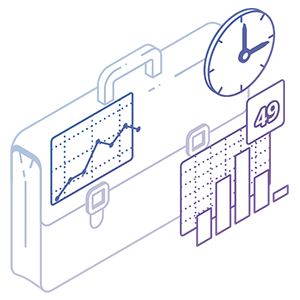Key Takeaways
- Agile planning is not less planning - it's continuous planning.
- Agile planning manages evolving requirements by welcoming change, delivering frequently, and forecasting probabilistically.
- Agile plans are defined by customer value, minimal upfront detail, and data-driven decisions.
"Failing to plan is planning to fail." Alan Lakein's line captures a truth that project managers still face today. Planning matters.
But in the Agile world, planning looks very different. Instead of locking teams into fixed scopes and rigid deadlines, agile planning creates just enough structure to guide progress while leaving space to adapt. It's iterative, flexible, and focused on delivering customer value.
And while Agile started in software, agile planning now applies across industries - marketing, product development, operations - anywhere teams need to deliver outcomes in fast-changing environments.
What Is Agile Planning and What Are Its Key Phases?
Agile planning is the practice of preparing work in short, adaptable cycles instead of building massive project plans up front. Its foundation is the Agile Manifesto: early value delivery, customer collaboration, and continuous improvement.
Unlike traditional planning, Agile embraces uncertainty. Teams don't try to predict everything months in advance. Instead, they refine as they go, adjusting based on customer feedback and new information.
What Are the Six Levels of Agile Planning?
A helpful way to see this in action is through the Agile Planning Onion, which visualizes planning at six levels:
-
Strategy sits at the outer layer. Here, leadership sets the company vision and long-term objectives. Planning is broad, directional, and focused on "why."
-
Portfolio planning translates strategy into the selection of programs or products that best support it. Leaders decide where to place bets and how to allocate investment.
-
Product planning turns those portfolio decisions into high-level deliverables. It's about features and functionalities that fulfill the strategy.
-
Release planning commits to delivering certain features in a timeframe, usually monthly or quarterly. It answers, "What value will we deliver next?"
-
Iteration planning narrows further. Teams break down tasks and user stories to deliver incremental progress.
-
Daily planning closes the loop. Through stand-ups, teams sync on progress, blockers, and immediate next steps.
This "onion" reminds us that planning isn't one event - it's continuous and happens at multiple levels of detail.
Agile Planning vs. Traditional Planning
Traditional planning still has its place - for example, in construction or engineering, where scope is well-defined and changes are costly. But in knowledge work, traditional planning often collapses under change.
Agile planning is different. It embraces uncertainty and builds flexibility into the plan itself. Instead of resisting change, it uses change to create better outcomes.
Both approaches involve planning. But Agile replaces rigidity with adaptability.
How Does Agile Planning Manage Evolving Requirements?
Even the best-defined project scope won't survive intact when markets and customer requirements change. Agile planning assumes this from the start.
Because work is broken into short iterations, teams can absorb change without derailing entire projects. If a requirement changes mid-project, it can be reprioritized in the backlog and addressed in the following iteration.
Another key difference is that Agile planning encourages small batch delivery. Deliverables go out frequently, which means stakeholders can give feedback before teams go too far down the wrong path. It's far easier to pivot after two weeks than six months.
And crucially, probabilistic forecasting. Instead of promising a single delivery date, Agile teams give date ranges based on historical performance. For example, Monte Carlo simulations can show there's an 85% chance a project will finish by a certain date. This sets realistic expectations while still providing accountability.
»» Pro Tip: Modern agile project management tools build on this by combining continuous forecasting with two-tiered plans, giving managers real-time visibility into project status and deliverables. Businessmap takes this a step further at the portfolio level, where forecasts span across all projects. By running daily tasks on team boards and linking them to parent projects, organizations gain a live, connected view of progress and predictability.
 Connecting team projects to the same program on a single portfolio board in Businessmap
Connecting team projects to the same program on a single portfolio board in Businessmap
What Are the Key Characteristics of Agile Planning?
An agile plan looks and feels very different from a traditional one. Instead of long documents filled with fixed schedules, it has a few defining traits:
-
Customer-first value. Every plan starts by asking, "What does the customer need most?" Deliverables are defined by outcomes, not just outputs.
-
Commit late, adapt often. Details are added only when they're needed, preventing wasted effort on outdated plans.
-
Frequent delivery and feedback. Work is released in increments so assumptions can be validated quickly.
-
Focus on flow, not utilization. Agile planning manages the flow of work through a system, rather than trying to keep every individual 100% busy.
-
Built-in quality. Testing and quality assurance are continuous, not postponed to the end. This approach, inspired by Toyota's principle of "Build quality in," ensures that quality is maintained consistently, avoiding issues at the end.
-
Two-tiered planning. Teams plan initiatives at a high level but let smaller tasks be pulled "just in time."
-
Data-driven forecasting. Teams rely on metrics like cycle time and throughput to predict delivery, not guesswork.
This approach doesn't mean less planning. It means smarter planning - planning that acknowledges uncertainty and works with it instead of against it.
 Using Monte Carlo simulation to forecast how many tasks can be completed in 30 days using Businessmap's built-in analytics
Using Monte Carlo simulation to forecast how many tasks can be completed in 30 days using Businessmap's built-in analytics
How to Create an Agile Plan?
So how do you put this into practice?
Agile planning usually begins with major deliverables. Let's say your company wants to launch a new website. At the highest level, you might define deliverables like "design," "development," and "marketing rollout."
From there, you break each deliverable into smaller work items - user stories, tasks, or epics. These items go onto a timeline or roadmap so stakeholders see how the pieces fit together.
The key is to plan only as much as you need right now. Instead of detailing every task months ahead, you refine continuously as new information emerges.
At Businessmap, for example, teams connect a roadmap timeline with detailed Kanban boards. Managers can zoom out to see how the project aligns with strategy, or zoom in to see which tasks are stuck. This dual view provides clarity without sacrificing flexibility.
And because tasks flow through a Kanban system, bottlenecks are visible immediately. Teams can swarm blockers, reassign resources, and keep the plan alive instead of watching it become obsolete.
What Tools Support Agile Planning?
Agile planning tools bring structure to this process. They support sprint planning, backlog refinement, forecasting, and progress tracking.
But tools only work if teams know how to set them up and use them consistently. This means success with tools comes down to two things:
-
Ease of setup. A Kanban board or sprint backlog should take you a few minutes to configure.
-
Training and standardization. Companies must decide how features, fields, and workflows will be used across teams. Without it, data becomes messy and reporting fails.
Some teams prefer lightweight whiteboards when they don't want a rigid structure. Others look for feature-rich platforms that include forecasting and portfolio alignment. The right choice depends on your context - but skipping training is a guaranteed path to failure.
What Is the Best Agile Planning Software in 2025?
Here's how leading platforms recognized by Gartner in the Enterprise Agile Planning category compare this year:
| Tool |
Best for |
Setup & Ease of Use |
Reporting/Analytics |
Pricing & Trials |
| Businessmap |
Scaling agile & portfolios |
Quick setup; rich onboarding tutorials; in-house success team |
Advanced flow metrics, forecasting; dependency management; portfolio visualization; goal management |
$5400/annually for 50 users; 14-day trial |
| Jira Align |
Enterprise agile scaling |
Steep setup, requires training |
Portfolio dashboards, OKRs |
$77,400/annually for 50 users (minimum number of users allowed); no free trial |
| Rally (Broadcom) |
Large enterprises, SAFe |
Complex, enterprise focus |
Custom reports & charts for flow metrics |
Custom pricing |
| Targetprocess (Apptio) |
Scaling frameworks (SAFe/LeSS) |
Highly configurable, training needed |
Portfolio visualization, dependencies |
Custom quotes; tree trial available |
Businessmap is the most flexible software
to align work with company goals







 Connecting team projects to the same program on a single portfolio board in Businessmap
Connecting team projects to the same program on a single portfolio board in Businessmap Using Monte Carlo simulation to forecast how many tasks can be completed in 30 days using Businessmap's built-in analytics
Using Monte Carlo simulation to forecast how many tasks can be completed in 30 days using Businessmap's built-in analytics


